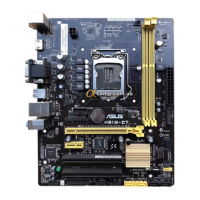2-24
Chapter 2: Getting started
2.8.2 Bootup NumLock State [On]
[On] Sets the power‑on state of the NumLock to [On].
[Off] Sets the power‑on state of the NumLock to [Off].
2.8.3 Wait for ‘F1’ If Error [Enabled]
When this item is set to [Enabled], the system waits for the F1 key to be pressed when error
occurs. Conguration options: [Disabled] [Enabled]
2.8.4 Option ROM Messages [Force BIOS]
[Force BIOS] The third‑party ROM messages will be forced to display during the boot
sequence.
[Keep Current] The third‑party ROM messages will be displayed only if the third‑party
manufacturer had set the add‑on device to do so.
2.8.5 Interrupt 19 Capture [Disabled]
[Enabled] Allows the option ROMs to trap Interrupt 19.
[Disabled] Disables this function.
2.8.6 Launch CSM [Enabled]
[Enabled] For better compatibility, enable the CSM to fully support the non‑UEFI
driver add‑on devices or the Windows
®
UEFI mode.
[Disabled] Disable the CSM to fully support the Windows
®
Security Update and
Security Boot.
The following item appears when you set Launch CSM to [Enabled].
Boot option filter [Enabled]
Allows you to select the type of devices that you want to boot up. Conguration
options: [UEFI and Legacy] [Legacy only] [UEFI only]
2.8.7 Secure Boot
Allows you to congure the Windows
®
Secure Boot settings and manage its keys to protect
the system from unauthorized access and malwares during POST.
Secure Boot [Enabled]
Allows you to select your installed operating system.
[Enabled] Executes the Microsoft
®
Secure Boot check. Only select this option
when booting on Windows
®
UEFI mode or other Microsoft
®
Secure Boot
compliant OS.
[Disabled] Get the optimized function when booting on Windows
®
non‑UEFI mode,
Windows
®
Vista/XP, or other Microsoft
®
Secure Boot non‑compliant OS.
Only on Windows
®
UEFI mode that Microsoft
®
Secure Boot can function
properly.

